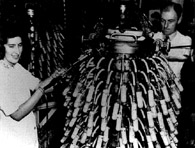
Penicillin
1944
life-saving antibiotic
The story of penicillin, a drug that revolutionised the fight against infection, is a good example of the difference between discovery and innovation.
The discovery: In 1928 Alexander Fleming noticed a mould growing on a discarded culture dish in his London laboratory. On closer examination he saw that either the mould or something in it was stopping bacteria from growing anywhere near it.
Fleming made a broth of the mould to test its antibacterial qualities but stopped investigating when his first results were disappointing. Yet the mould was actually making penicillin, the miracle drug of the century.
The innovation happened in 1939, when Australian medical researcher Howard Florey teamed up with German biochemist Ernst Chain at Oxford University in England. They purified penicillin from a special strain of Fleming's mould that they developed. Florey established and led a large research team at a time when most scientists worked alone. The team showed how penicillin could fight bacterial infection in mice and humans, and then began working out how to mass-produce it.
For fear of their work being destroyed in an air raid, Florey and Chain rubbed spores of the mould inside their trouser pockets when they left the lab at night.
Other Australians on Florey?s team included chemists John Cornforth and Rita Harredence, who were involved in working out the atomic structure of penicillin; Ethel Florey, who closely supervised the early clinical trials in Britain; and Hugh Cairns, who supervised trials on war wounds in Africa. Under the pressure of war and with the aim of saving the lives of many wounded in action, the team worked intensely.
Great Britain couldn't afford to manufacture penicillin. In 1941 Florey turned to the USA where mass production of the wonder drug was made part of the 'war effort'. But there its use was limited to treating war wounds and for life-or-death civilian cases. Australia was the first country to manufacture penicillin for the domestic market, in 1944 at the Commonwealth Serum Laboratories in Melbourne.
The drug soon became a front-line tool of medicine around the world. It saved many lives, and its availability and efficacy freed people from fear of infection by common bacteria. The growing problem of penicillin resistance in bacteria (first noted by Ethel Florey in her clinical trials) has reduced its efficacy, but it is still useful in combatting many infections.
Who Did It?
Key Organisations
CSL Limited : R&D, manufacture
Key People
Howard Florey : researcher and team leader
Ernst Chain : process developer
Ethel Florey : clinical trials leader
Further Reading
The birth of penicillin and the disarming of microbes
R Hare
Allen & Unwin, London, 1970.
Links
The
Lab. Maker of the Miracle Mould
Nobel
Prize 1945 presentation speech
Bright
Sparcs
Quantum
- Passing the Bug
Antibiotic
resistance
The
Lab. The Bug Stops Here
Related Innovations
Disposable syringe
X-ray crystallography
Powerhouse Museum Objects
Penicillin mould specimens
Report on penicillin
|










